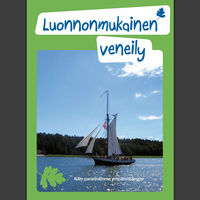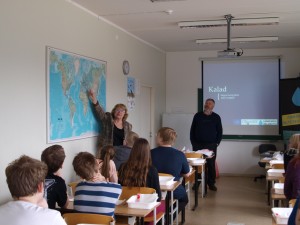Information
Information
Many water protection activities depend on the support and activity of citizens. Whether such action takes the form of allocating resources for building, renovating wastewater treatment systems, making environmentally friendly, everyday consumer choices or actively participating in water protection activities, communication forms a major part in the success of any activity. Success depends on the awareness, knowledge and behaviour of people in general. Communication and education are the main tools for achieving change in these respects. This is particularly relevant at local level, where success often depends on grassroots support and activity
This communication strategy aims to empower local governments, NGOs and other organisations dealing with environmental issues to develop their activities in order to improve the environment around the Baltic Sea. As a tool for these organisations, communication has the role of making sense of the issues, increasing our knowledge and activating/inspiring people to participate in environmental action in a responsible way.
The communication strategy was compiled by Tallinn University Institute of Communication in the EU Life+ funded project CITYWATER.
The need of communication strategy
The communication strategy is based on two background reports conducted by the Tallinn University Institute of Communication as part of the EU Life+ funded project CITYWATER. The reports surveyed people in all three Baltic countries, and coastal municipalities in Estonia, Latvia, Lithuania and Finland (see Extras), about their water protection-related attitudes and behaviour.
The following results were highlighted:
- People have little belief in their own capabilities with respect to water protection, although they consider water protection to be necessary. When people were asked what they can do to protect the local water environment, half either answered that they cannot do anything or were unable to mention an activity of this kind.
- People consider national governments, the European Union and industry to be the actors with most responsibility for protecting the Baltic Sea. Local municipalities, however, view themselves and citizens as having the greatest responsibility for such work.
- People regard the local municipality as the key point of contact in environmental matters. People prefer notifying the local municipality or media as a way of influencing environmental decisions.
- Local municipalities view citizens as substantial causes of pollution risks and therefore see raising public awareness as one of their main environmental protection responsibilities. Such activities are high on their agenda. However, lack of resources – money, knowledge and human resources – often hinder the successful implementation of such activities.
Bank of Actions
Bank of Actions
 | Booklet: Natural boatingNavigation Union of Finland |
 | Communication strategy for local level water protectionTallinn University, Institute of Communication |
![]() Agriculture
Agriculture
![]() Awareness raising
Awareness raising
![]() Hazardous materials
Hazardous materials
![]() Littering etc.
Littering etc.
![]() Oil spill prevention
Oil spill prevention
![]() Research and monitoring
Research and monitoring
![]() Shipping and boating
Shipping and boating
![]() Stormwater management
Stormwater management
![]() Strategies and programs
Strategies and programs
![]() Wastewater management
Wastewater management
![]() Other
Other
![]() Drainage basin
Drainage basin
Instructions & recommendations
Instructions & recommendations
Communicating water protection to citizens and relevant stakeholders
The implementation of a communication strategy includes the following stages:
- Define the problems
- Set the communication goals
- Formulate possible messages for different stakeholder groups
- Select potential activities at local community level
- Identify potential resources
- Analyse communication actions to make the communication process more effective
Strategic communication goals and actions in the Baltic Sea region
We propose six major communication-centered activities that can contribute to a better health of the Baltic Sea and local water systems. These goals are complementary, meaning that none of them is individually powerful enough to help solve the highlighted problems but many of these need to be enacted in a concerted way. For each goal we list actions:
[xa_acc style=”xa-default”]
[xa_slide title=”To raise awareness about the problems of the Baltic Sea” icon=”plus”]All local-level water protection issues are related in some way to broader-scale issues, especially to the condition of the Baltic Sea. Since this connection is seldom made, it is important to point out the relevance of the Baltic Sea to the general public and decision-makers. This will also enable a public discussion of the potential benefits of water protection (e.g. social economical, ecological and recreational benefits).
Action 1: Baltic Sea Celebrations: dedicated days in organizations, municipalities, regions.
Involved actors: Municipalities, activists, scientists, schools, media, local businesses.
Required resources: Local municipality budget, sponsors, project funding, volunteers.
Suggested frequency: Once per year
Analysing effectiveness: Public opinion surveys, attendance
Action 2: Environmental communication strategy of the municipality
Involved actors: Municipality communication team, civil servants
Required resources: Municipality budget
Suggested frequency: Continuous
Analysing effectiveness: Public opinion surveys, public sentiment at events[/xa_slide][xa_slide title=”To increase citizens’ knowledge” icon=”plus”]Factual knowledge alone is not enough to trigger changes in behaviour, but it is a potent tool for raising awareness and motivating people to become active. Various events or educational programmes – lectures, workshops, seminars and regular evening courses – can help people to understand their impact on the environment (e.g. the Baltic Sea) and how to become more environmentally friendly, whether at home, in the workplace or when on vacation.
Action: Educational programs for adults, distribution of factual material
Involved actors: National and local governments, NGOs, media, experts
Required resources: Government and local budget, project funding
Suggested frequency: Regularly (e.g. once or twice per month)
Analysing effectiveness: Media monitoring and analysis, feedback at events[/xa_slide][xa_slide title=”To engage public in the environmental risk management” icon=”plus”]Public discussions are mandatory prior to various political decisions with an environmental impact. If used skilfully, these can be powerful tools for empowering the local community and leading it to adopt environmentally friendly behaviour. Such events can help to provide the necessary trust and act as a forum for the discussion of wider environmental issues, while taking account of local concerns.
Action 1: Public discussions prior to decisions, engagement events, engagament skills trainings
Involved actors: Local government, NGOs, local community organizations
Required resources: Municipality funding, volunteers
Suggested frequency: Continuous, Depending of decision-making
Analysing effectiveness: participation, level of engagement, consideration of community problems in decision making
Action 2: Risk and crises communication plan for municipality
Involved actors: Municipality communication team, civil servants
Required resources: Municipality, media, stakeholders (potentional polluters)
Suggested frequency: Continuous
Analysing effectiveness: Response to environmental problems, level of trust in community[/xa_slide][xa_slide title=”To increase citizens’ activity and change behaviour” icon=”plus”]People’s water protection activities can be initiated with the help of regular events or campaigns. The key is to empower people, i.e. to make them feel responsible for the environment and capable of changing it for the better. These attitudes will increase the likelihood of environmental-friendly behaviour (if supported by infrastructure) and the public’s motivation to engage in water protection-related activities.
Action 1: Active participation campaigns with different water /sea/environment related topics
Involved actors: Local municipalities, schools, NGOs, local community organizations
Required resources: National budget, local municipality budget, project funding, volunteers
Suggested frequency: 1-2 times per year
Analysing effectiveness: Number of participants, observing behavioural outcomes
Action 2: Creating supportive infrastructure for behavioural change
Involved actors: Local municipalities, experts, local communities
Required resources: National and municipality budget, project funding
Suggested frequency: continuous maintenance and improvement
Analysing effectiveness: Use of infrastrucutre, observing behavioural outcomes[/xa_slide][xa_slide title=”To engage stakeholders groups” icon=”plus”]Agriculture, local industry and other groups are a key part of the local community and can play a major role in supporting water protection. The aim is to increase their awareness of their responsibilities and to provide them with the tools they need to reduce their environmental load.
Action: seminars and others engagement events, discussions prior decisions
Involved actors: Municipalities, stakeholders, experts
Required resources: Municipality budget, project funding, civil servant dedication
Suggested frequency: Continuous
Analysing effectiveness: Participation, level of engagement, feedback analysis[/xa_slide][xa_slide title=”To build up local networks” icon=”plus”]Cooperation always works better if people know and trust each other. At local level, this is often the most crucial factor. It is therefore vital that people are engaged in water protection activities both within networks and on various levels– as officials, in NGOs, as volunteers – thus regularly communicating with and engaging the local community in the (which? municipality’s water protection?) activities. They will also need the necessary skills to initiate public activities, promote environmental issues and engage citizens in participation etc.
Action: Regular seminars, informal events and interaction
Involved actors: Municipality, stakeholders, NGOs, local community organizations etc
Required resources: Municipality budget, civil servant dedication
Suggested frequency: Continuous
Analysing effectiveness: Activity and size of the network, feedback analyses[/xa_slide][/xa_acc]
Key components of successful communication
When planning communication activities, identifying and allocating resources and performing effectiveness analysis are key structural components for success.
Resources
Our surveys show that lack of resources is a constant challenge for local municipalities. Therefore any allocation of resurces need to be carefully planned and the need for this widely accepted. It all begins with the awareness among the municipalities themselves.
Financial resources for environmental communicative actions should be set aside within local government budgets as well as at national level. While free tools, such as the social media, can be used, steady funding would enable the achievement of strategic goals more effectively than single, sporadic campaigns.
Social resources mainly refer to good cooperation between actors, well organised networks and the participation of volunteers. This also refers to the skills deployed in communication and engagement.
An active local network would also allow using the resources available to other actors, both financial and social. Collaboration with local businesses as part of their social responsibilty strategy is one example.
Effeciveness analysis
All activities should be carefully evaluated to ascertain their effectiveness and success or failure. Analysis and the establishment of different feedback systems should be intrinsic to all communicative actions and educational programmes.
Messages
Messages are always specific to the local context and stakeholder groups. There are no universal messages that work everywhere. But we still offer some examples that could be used and adapted:
- Our welfare and good health depend on the health of the sea and other water bodies.
- We all matter. Every action counts in preventing pollution and keeping the environment clean.
- All is connected: what we do in our home will also affect the Baltic Sea and thereby contribute to either a better or worse life for us and our children
Role of education
An efficient way to reach the strategic goals presented in this report is to work with kinder gardens and schools in developing special events/courses/classes to inspire young people about environmental issues. The awareness and behaviour of children will also influence their families and other people around them, therefore it is an important component of environmental change. We fully acknowledge this and encourage the use of environmental education, however, educational measures are not a focus of this strategy.
Extras
Extras
Publications from Tallinn University and the CITYWATER project
Communication strategy. Empowering local actors: Communication strategy for local-level water protection activities. Link_to_the_report
Citizens´survey report: Local actors and the Baltic Sea 1: attitudes towards water protection among the population of the Baltic countries. Link_to_the_report
Municipalities´survey report: Local actors and the Baltic Sea 2: Water protection attitudes and activities in coastal municipalities. Link_to_the_report




